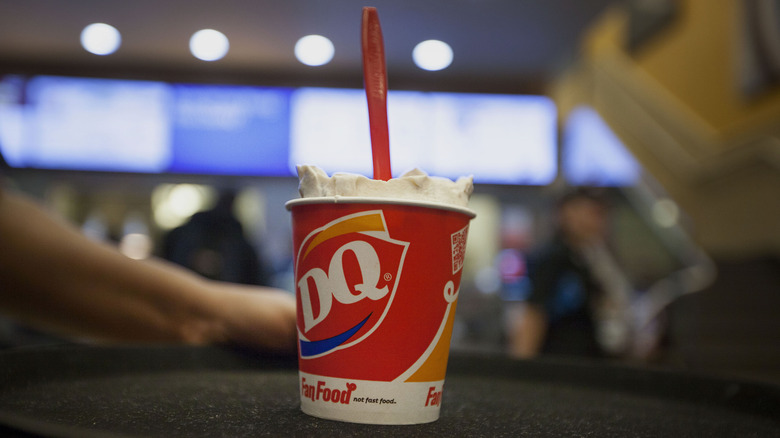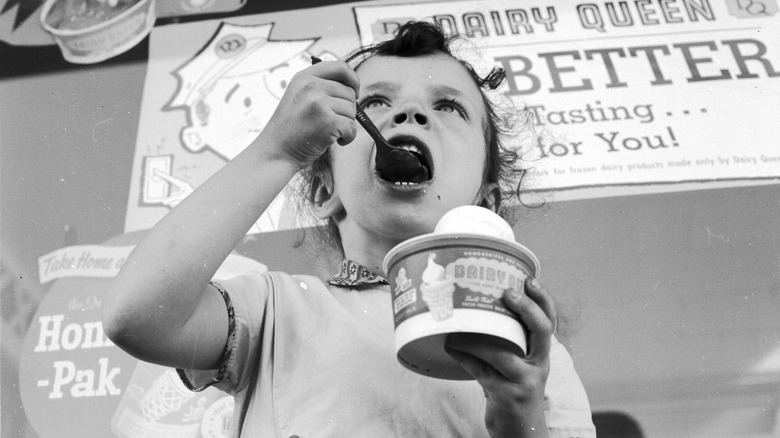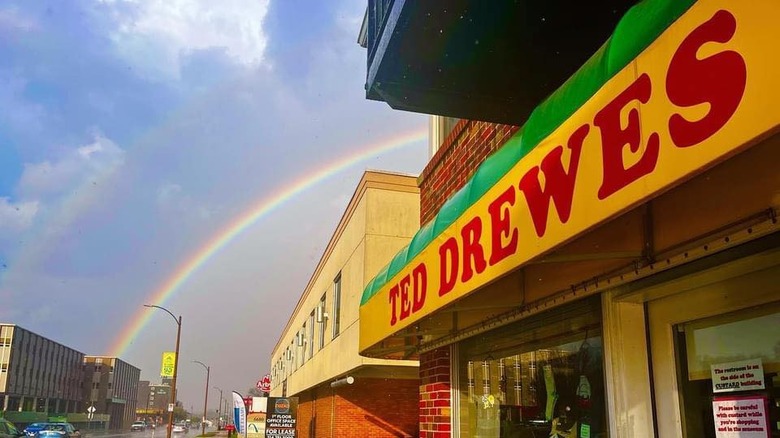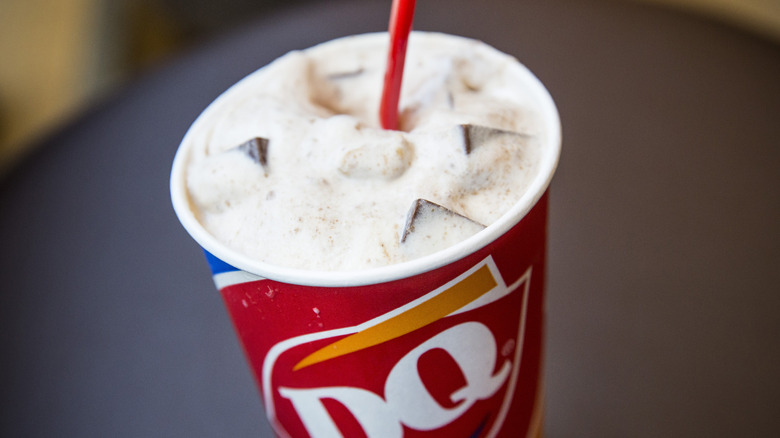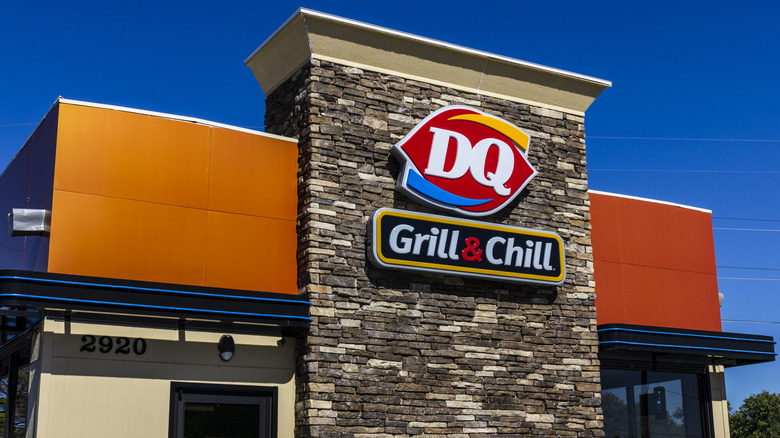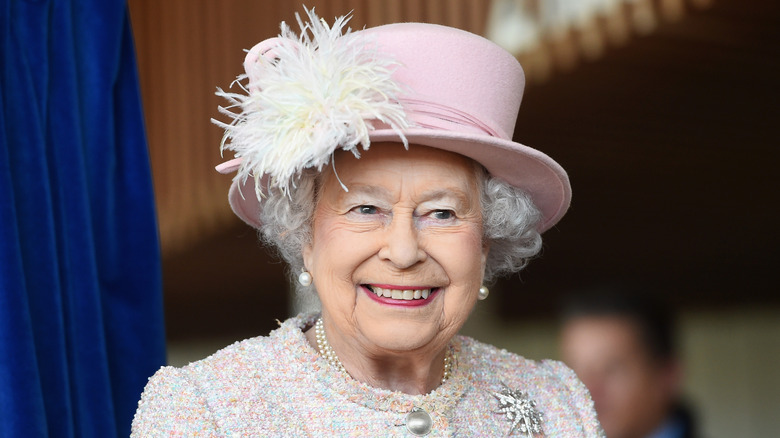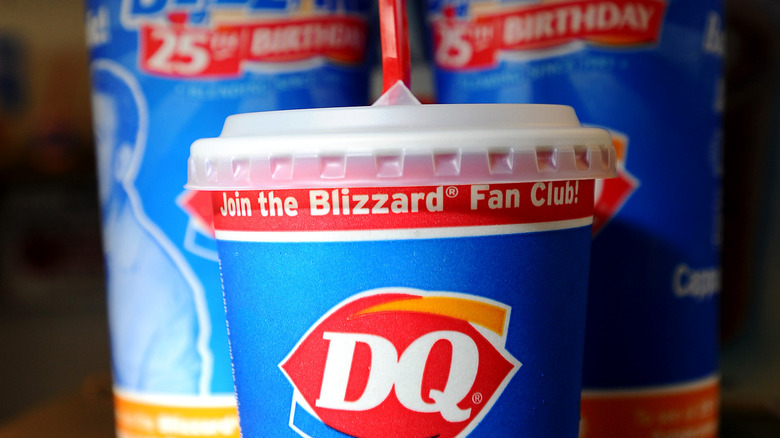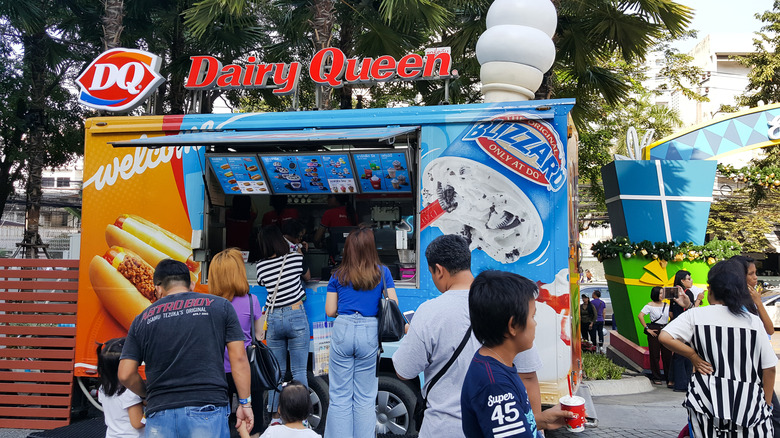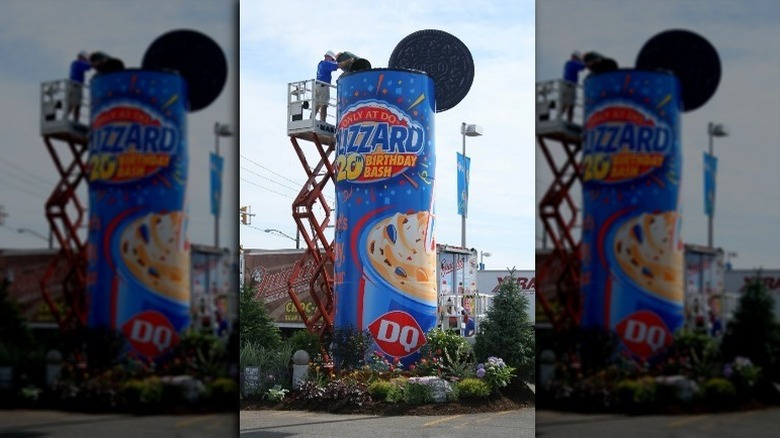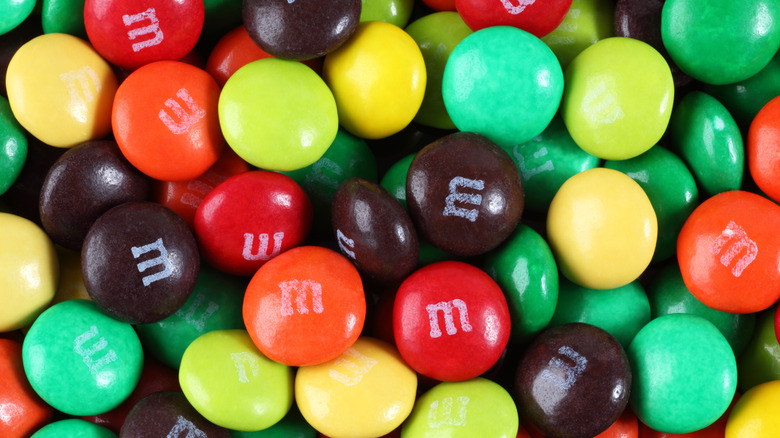13 Things Only True Dairy Queen Fans Know About The Iconic Blizzard
The Dairy Queen (DQ) Blizzard has become one of the most recognizable fast food desserts around the world. Sales of the Blizzard reached $1.1 billion in 2020 — and according to Mirus, this single menu item accounts for over 23% of Dairy Queen's total sales. Simply the introduction or return of a Blizzard flavor can lead to a surge in customer interest, with seasonal options such as the summertime Caramel Fudge Cheesecake Blizzard and the autumn Pumpkin Pie Blizzard quickly becoming fan favorites.
Undoubtedly, the Blizzard is a big reason why QSR ranked Dairy Queen as the 17th-largest quick-service restaurant in the U.S. for 2022. And with the company constantly doing new promotions focused on the frozen treat, such as selling 85-cent small Blizzards for a limited time in 2023, it's clearly a focal point of DQ's business model and brand.
But there are many things that people don't know about the Blizzard. Where and why was it created? Was the Blizzard popular right away? Where did the "flip test" come from? We've put together some fascinating facts about the DQ Blizzard that only true fans know. By the time you've finished, you might be ready for another Blizzard yourself. (We already are.)
1. The current Blizzard isn't the original
Let's start with something that even some Blizzard diehards may not realize — the Blizzard you're familiar with is really the second generation of the treat. Dairy Queen itself has noted the first attempt at something resembling the Blizzard came in the early 1950s — and it may have been using the Blizzard name as far back as 1946.
Initially, the product was a shake with a reduced amount of milk. Later, the company tried eliminating the milk and topping the dish with fruit. But while customers enjoyed these early Blizzards, franchisees did not. The dessert was so thick that it put too much strain on the mixers and they kept failing, much to the owners' chagrin. At the time, DQ franchises were much more loosely affiliated than they are now. With no corporate mandate to keep serving them, the item quietly disappeared from menus.
The Blizzard wasn't the only new treat that DQ tried during the 1950s. It started offering banana splits in 1951 and introduced the Dilly Bar in 1955. But while the Dilly Bar quickly became a hit that is still around today, DQ lovers would have to wait more than 30 years for another attempt at Blizzard magic.
2. The modern Blizzard was inspired by local competition
It wasn't until the mid-'80s that the idea of the Blizzard started buzzing again. And interestingly, it built on ideas borrowed from two competing frozen dessert stores. Samuel J. Temperato, a St. Louis-area franchisee who owned 67 Dairy Queens at the time (and would eventually own 80-plus), is credited by DQ as the inventor of the Blizzard. But even at the time, Temperato freely admitted he got his inspiration elsewhere.
The first piece of the Blizzard puzzle was Ted Drewes Jr., who operated Ted Drewes Frozen Custard in St. Louis. At the time, the bestselling product at Drewes' store was Concrete. Invented in 1959, this was simply a malt shake blended sans milk, resulting in an incredibly thick concoction.
However, Concrete did not have any add-ins. For this, Temperato drew on another frozen custard seller. As he told the St. Louis Dispatch in 1986, a now-defunct store called Huckleberry's was putting crushed candy and cookie pieces into its treats. To quote Temperato directly, "When I walked in there and tasted some of the product, I said, 'We've got to have this at Dairy Queen.'" By combining the two desserts, Temperato had something that would eventually become a worldwide phenomenon.
3. The Blizzard needed some fine-tuning
The Blizzard wasn't perfect out of the gate, though. Temperato — who is also credited with developing DQ's "Full Meal Deal" — started serving the Blizzard at his locations in 1983, then showed it to corporate headquarters in the spring of 1984. While DQ was intrigued, one of the initial challenges was the same thing that derailed the original attempts in the '50s: having a mixer powerful enough to make it.
Enter Ronald Medd, another DQ franchisee based in Iowa. Starting with the spindle and motor, he completely redesigned the mixing machine. The result was the "Blizzard Blender," which could quickly make a Blizzard and cost $500 in mid-'80s money (more than $1,400 today). The design was eventually patented, though many workers disliked the loud whine.
Another big thing was deciding whether to include candy and cookies. Initially, DQ wasn't going to include the treats, but after a test run with the name "Concrete Blizzard" flopped, DQ went back to the drawing board. After revisiting the candy question, the company ultimately decided to include it after all. It wasn't exactly altruistic, though — DQ simply realized candy would give it a lot more brand recognition. Either way, it set the stage for the Blizzards we know and love today.
4. Some candy and cookie companies resisted involvement
Next was getting candy and cookie companies to consent to the use of their products. Some manufacturers, like Heath, were immediately on board. Heath even purchased a candy crusher that operated 24 hours a day to supply Heath bar bits to DQ locations.
Other businesses, though, were hesitant or outright hostile. M&M/Mars (now Mars, Inc.) initially refused to sell candy to DQ, as did Oreo. However, Hydrox, a competitor of Oreo, agreed to partner up for the initial Blizzard launch.
The good news is that after the Blizzard debuted (more on this in a moment), Oreo and M&M/Mars reconsidered and started selling their products to DQ. There was still a catch, though — the brands would only sell the candy and cookies in their unaltered form. As an M&M/Mars spokesman told the The New York Times in 1986, "To us, a quality product is a complete bar."
That meant DQ staff initially had to spend hours each day crushing the candy and cookies. In-house crushers were soon developed to make the process more efficient. With chopped bags of candy like Snickers and Butterfinger now widely available, it's safe to say the manufacturers have come around. But we can only imagine trying to manually crush candy bars while hungry customers are demanding a Blizzard.
5. The Blizzard rejuvenated Dairy Queen as a business
After a successful test market run over the winter of '84, the Blizzard was finally ready and launched company-wide in early '85. To say it was successful would be a massive understatement: It sold more than 75 million Blizzards in the first year. At $1.29 for a 12-ounce small Blizzard and $1.99 for a large 21-ounce Blizzard, that's a lot of dough.
Not surprisingly, the Blizzard almost single-handedly gave Dairy Queen a jolt. Samuel Temperato, the man behind the Blizzard, reported his sales in 1985 were 28.1% higher than the previous year. On a larger scale, DQ's total profit jumped from $9.6 million in 1985 to $13 million in 1986 — a boost of more than 35%.
The stock price also soared, going from $40 a share at the start of 1985 to $72.50 in mid-October. Dairy Queen split its stock 5-for-1 in February 1986, and by September 1986, those new shares listed at $25. That means the pre-split shares were worth $125, a 212.5% increase in just 21 months. Incidentally, the candy companies made out well, too. In 1986, Heath said DQ accounted for about 7% of its candy bar production and credited the partnership with reviving business.
6. The Royal Blizzard series is a tribute to Queen Elizabeth
It would be easy for DQ to rest on its laurels and let the Blizzard speak for itself. But over the decades, it has continually found ways to put new twists on it and cement it as company royalty.
Notably, in April 2016, DQ launched Royal Blizzards to celebrate the late Queen Elizabeth's 90th birthday. These "stuffed Blizzards" have a center of marshmallows (Reese's Fluffernutter), strawberries (New York Cheesecake), or fudge (Ultimate Choco). Both the Mini and Royal Blizzards remain on the menu, though the Royal lineup was DQ again swiping a competitor's concept — in this case, the "Core" pints introduced by Ben & Jerry's in 2014.
It wasn't even its first big move of the decade. In August 2010, DQ unveiled the "Mini Blizzard," which is half the size of the small Blizzard. It also embarked on a 25-city tour with the "Blizzardmobile," giving out free Mini Blizzards to recognize the dessert's 25th anniversary.
More recently, we have the 85-cent Blizzards, which DQ offered in April 2023 and again in September 2023. (The price was in honor of the 1985 debut.) The promo was a resounding win-win. Customers got a great deal on a small Blizzard, which normally retailed for around $3.69 at the time. On the corporate side, QSR reported DQ app downloads jumped a whopping 974% in April, and its digital marketing partner Braze claimed an average revenue growth of 138%.
7. It is technically made of ice cream now
After many years, you can now call a Blizzard "ice cream" — but not because of anything Dairy Queen did. Per the USDA, to be considered full-fledged ice cream, a frozen dairy dessert must contain at least 10% milkfat (also called butterfat). Conversely, Dairy Queen is open about the fact its desserts are only 5% milkfat. By comparison, Haagen-Dazs has a milkfat content of 15%. While there are allowances for "bulky ingredients" like chocolate, fruit, and nuts, DQ still does not meet the 10% standard.
For many years, a 5% butterfat content placed DQ desserts in the federal category of ice milk. This led DQ to go with the more appealing name of "soft serve," and the Blizzard — which uses said soft serve — was labeled a "treat." Recently, though, the USDA updated its regulations under the Nutrition Labeling and Education Act, replacing ice milk with the categories of reduced-fat, light, and low-fat ice cream.
Under these new labels, DQ soft serve and Blizzards are now officially considered "reduced fat" ice cream. However, DQ is adamant its recipe is the same as it has always been. So it wasn't the DQ Blizzard changing to become true ice cream so much as a technicality in new labeling standards.
8. The upside-down test was also borrowed
Even many casual DQ Blizzard fans are familiar with the upside-down test, wherein the server flips the dessert upside down to show your Blizzard is so thick it won't spill. Given what we've discussed so far, though, you might not be surprised to learn this test came from elsewhere.
For it, we can go back to the Concrete dessert from Ted Drewes Frozen Custard, which has been served upside-down since its inception. As the story goes, in the summer of 1959, 14-year-old Steve Gamber would bike to Drewes' custard stand every day for a chocolate malt — and each time, he said he wanted his malt to be thicker. Drewes kept thickening Gamber's malts, but the teenager was never satisfied. Finally, one day Ted turned a malt upside-down, saying to Gamber, "Is this thick enough for you? If it falls out (of the cup), it's free."
Thus a legendary quality-control test was born. (Incidentally, Gamber did pay for that upside-down malt.) Starting in 2016, DQ went all-out with the "Upside Down or Free" campaign, stating that if a server didn't flip your Blizzard upside-down, you'd get a coupon for a free Blizzard. Granted, there is an avalanche of exceptions, such as that franchisees get to choose whether to participate. But it showed a commitment to quality that goes back to one of the Blizzard's forefathers.
9. Many unique flavors are available overseas
There have been hundreds of Blizzard flavors served to U.S. and Canadian customers over the years, thanks in part to the Blizzard of the Month promotion introduced in 2003. Still, it barely scratches the surface of Blizzard possibilities. Dairy Queen franchises locations in more than 20 countries, and each puts its own spin on the treat.
One of the most notable is China, where DQ first expanded in 1990. Former China and Southeast Asia DQ manager Kevin Lee once told Fortune that northern China customers prefer strong, fruit-based flavors and weren't as big a fan of chocolate in their desserts, which meant changing some of the offerings. Conversely, southern China residents are all about green tea as a flavoring agent. And yes, that means green tea DQ Blizzards.
Dairy Queen locations in the Philippines feature Blizzard flavors like Mango Cheesecake, Double Dutch, and Chocolate Kit-Kat. If you go to a DQ in Mexico, you'll find Tropical, Hawaiian, and De La Rosa Marzipan Blizzards on the menu. You'll also find many of the "standard" Blizzards if you prefer something familiar, but an overseas DQ is also a great opportunity to let your taste buds branch out.
10. There's a record for the World's Largest DQ Blizzard
Have you ever thought to yourself that a large Blizzard just isn't big enough? On June 21, 2005, in Springfield, Massachusetts, the question was answered of just how huge a Blizzard can be. To celebrate both the first day of summer and the 20th anniversary of the dessert, franchisee Sam Cowles set the Guinness World Record for the largest DQ Blizzard ever made.
In a fundraiser for the Children's Miracle Network, Cowles and a team of 20 volunteers used over 700 gallons of DQ soft serve and 3,000 pounds of Oreos, which was the most popular Blizzard flavor at the time. The resulting treat towered 22 feet high and weighed a whopping 8,224.85 pounds. It reportedly took nearly two weeks to make the record-setting Blizzard. (no word on how long it took to eat.)
Remarkably, that wasn't even Cowles' first attempt at a humongous Blizzard. In 1999, he set the inaugural record at his Chicopee, Massachusetts location, constructing a DQ Blizzard that weighed more than 5,300 pounds. When word gets out of the next record Blizzard try, remember to bring your spoon.
11. DQ has gone to court over the Blizzard name
The recent history of the Blizzard hasn't been all fun and games, though. Warren Buffet's holding company Berkshire Hathaway Inc. bought Dairy Queen in 1998. At least twice since then, it resorted to litigation to try and protect its assorted Blizzard trademarks. In 2010, Dairy Queen sought an injunction to make Yogubliz, Inc., a frozen yogurt chain in Los Angeles and Las Vegas, stop using the names "Blizz" and "Blizzberry" for desserts. The request claimed customers could get confused over the similar names. However, a U.S. District Court judge denied the request, saying it wasn't obvious the names in question had any meaning beyond the specific products they were marketing.
Then in 2022, Dairy Queen filed a lawsuit against, of all things, an office supply company. W.B. Mason Co. was selling bottled water under the "Blizzard" name, and DQ tried to stop it, against citing potential confusion — in this case, because DQ also sold bottled water at its restaurants. Dairy Queen again lost in U.S. District Court, with the judge observing the products in question had a "very different audience appeal."
12. DQ almost lost some of its candy Blizzards
Despite the many inventive flavors introduced over the years, candy and cookies remain the bedrocks of the Blizzard lineup. But not too long ago, it looked like M&M's, Snickers, Twix, and other Mars, Inc. candy brands could be disappearing from DQ. In 2016, news broke that Mars was considering removing its candy from all fast-food desserts, including the DQ Blizzard and the McDonald's McFlurry.
Reportedly, the company had concerns about the amount of sugar in such desserts, which went against the marketing image it was pushing of a balanced diet and moderation with treats. It was the first company to list nutritional information on its bars in 2008, and then eliminated king-size candy bars in 2013. Dropping fast food desserts would have been the next step in that movement — and if it happened, it would apply to DQs worldwide.
Ultimately, nothing came of the threat, with Mars receiving pushback from surprising sources. In an interview with Reuters, public health attorney Michele Simon called it "kind of silly" they were even considering such a move because "this is all junk food." As of this writing, M&M's and Snickers Blizzards are still on the DQ menu, and we've heard nothing more of candy companies wanting to get off the Blizzard train.
13. DQ now uses cage-free eggs in its Blizzards
Interestingly, at the same time it was in danger of losing the Mars, Inc. candies, Dairy Queen was starting its own efforts at a public image makeover. In 2016, the company announced it would start transitioning to cage-free eggs at its U.S. and Canada locations, with the aim of using 100% cage-free eggs by 2025. This meant all proprietary foods and ingredients, including soft serve and Blizzards. Dairy Queen also unveiled a chicken welfare policy stating its commitment to sustainable practices and humane animal treatment.
The next update came in 2021 when Dairy Queen disclosed that all Blizzards were now being made with cage-free eggs. Furthermore, DQ said that not only was it on track to meet its U.S. and Canada cage-free egg goal by 2025 as promised, but it was expanding the pledge globally with the same deadline. It's one more way to feel good every time you pick up a Blizzard from the nearest DQ.
